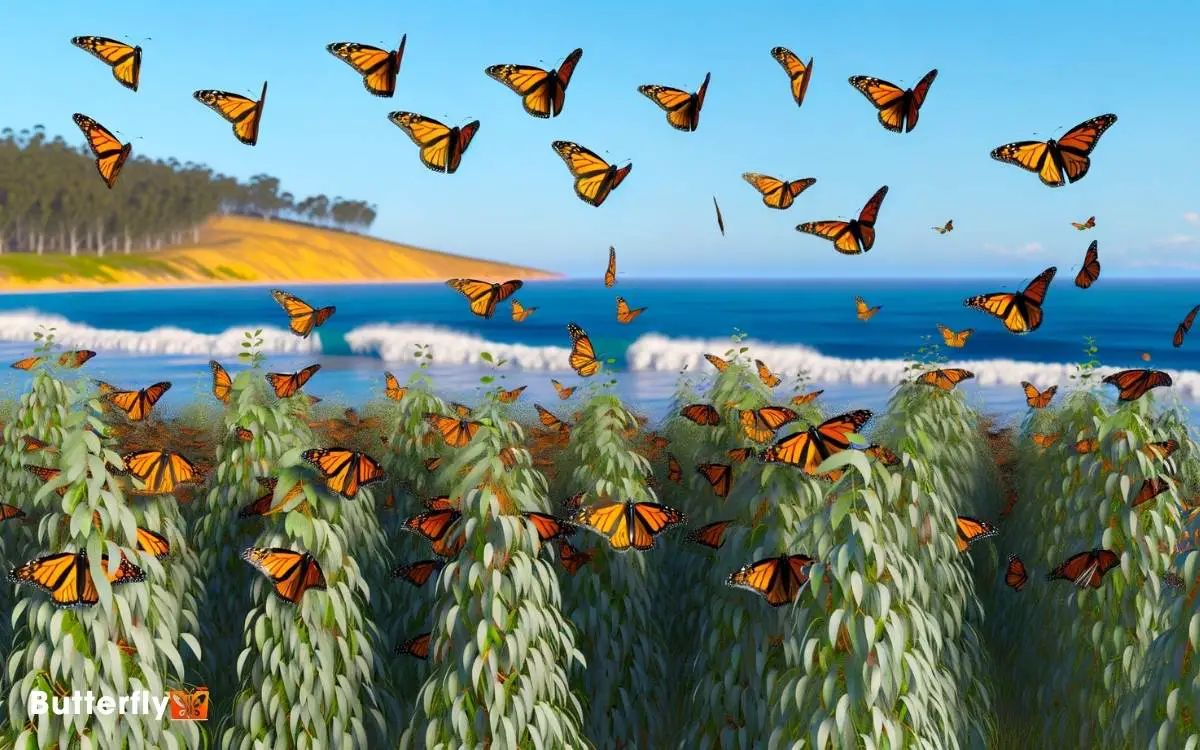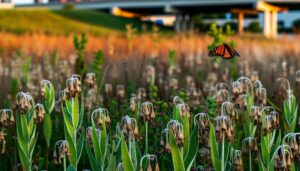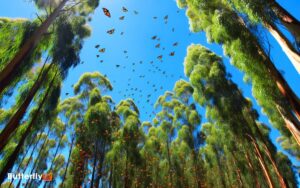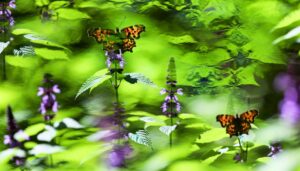Migration of Monarch Butterflies in California: Key Routes!
You’ll observe monarch butterflies migrating along California’s coast from late October to early March. They navigate coastal pathways and mountain passages, with key stopover sites like Pacific Grove and Pismo Beach providing essential nectar and stable microclimates.
Historical data shows significant declines since the 1980s due to urbanization, climate variations, and habitat loss. Monarchs rely on coastal groves for roosting in eucalyptus, Monterey pine, and cypress trees.
Climate change disrupts migration timing, affecting survival. Conservation efforts, such as planting native milkweed, are vital. Delving into these details will enrich your understanding of their remarkable journey.

Key Takeaways
Historical Overview
Through detailed historical records, you can trace the migration patterns of monarch butterflies in California back to the early 20th century.
By examining citizen science data, entomological surveys, and tagging studies, you’ll notice distinct trends and shifts in population densities.
Early 1900s records highlight overwintering sites along the California coast, with significant clusters observed in Pacific Grove, Santa Cruz, and Pismo Beach.
By the mid-20th century, these populations experienced fluctuations impacted by urbanization, climate variations, and habitat loss.
Importantly, annual counts from organizations like the Xerces Society provide quantitative evidence showing substantial declines in monarch numbers since the 1980s.
Historical data reveal both consistent migratory behaviors and adaptive responses to environmental changes, offering a detailed view of monarch butterfly ecology.
Migration Routes
You’ll observe that Monarch butterflies in California follow specific migration routes, including coastal pathways, mountain passages, and urban areas.
Coastal pathways, characterized by favorable temperatures and abundant nectar sources, support large populations.
You should also note that mountain passages present altitudinal challenges, while urban environments introduce obstacles like pollution and habitat fragmentation.
Coastal Pathways
Monarch butterflies in California mainly follow coastal pathways during migration, utilizing the mild climate and abundant nectar sources found along these routes. These coastal corridors offer vital conditions, minimizing energy expenditure and maximizing survival rates.
You’ll find that monarchs prefer specific locations, such as groves of eucalyptus and Monterey pines, which provide essential roosting sites.
| Location | Key Features |
|---|---|
| Santa Cruz | Eucalyptus groves, mild winters |
| Pacific Grove | Monarch Sanctuary, nectar plants |
| Pismo Beach | Butterfly Grove, coastal climate |
| Goleta | Ellwood Mesa, diverse flora |
| San Diego | Warm temperatures, ample nectar |
The coastal pathways’ consistent climate and flourishing vegetation are vital for the monarchs’ successful migration, ensuring they reach their wintering grounds with sufficient resources.
Mountain Passages
Mountain passages, characterized by cooler temperatures and high-altitude floral diversity, greatly influence the migration patterns of monarch butterflies in California. You’ll observe that these corridors offer essential resources and microclimates.
Monarchs often utilize these mountain routes for several reasons:
- Floral Availability: High-altitude regions provide diverse nectar sources, important for energy during migration.
- Thermal Regulation: Cooler temperatures at higher elevations help avoid overheating, especially during peak migration periods.
- Predator Avoidance: Mountain passages generally have fewer predators, offering safer travel for monarchs.
Data from telemetry studies show that monarchs prefer these pathways to maintain ideal body temperatures and access necessary floral resources.
By understanding these migration routes, you’ll gain insight into the complex decision-making processes monarch butterflies undergo during their seasonal journeys.
Urban Challenges
As monarch butterflies navigate through urban landscapes in California, they encounter unique challenges that greatly impact their migration routes.
Urbanization leads to habitat fragmentation, reducing the availability of milkweed and nectar sources essential for their survival.
Light pollution disrupts their navigation, while increased air pollution can impair their respiratory systems. Data from recent studies show urban areas have a 30% decrease in suitable habitats compared to rural regions.
High-rise buildings and traffic pose physical obstacles, often resulting in increased mortality rates. Observations indicate that urban heat islands can alter local climates, affecting the timing of migration.
You’ll find that these combined factors create a perilous journey for monarchs, necessitating urgent conservation efforts to mitigate these urban challenges.
Key Stopover Sites
Each fall, monarch butterflies rely on key stopover sites in California like Pacific Grove and Pismo Beach to rest and refuel during their extraordinary migration.
These locations provide essential resources for monarchs:
- Nectar Sources: Monarchs need flowering plants to replenish their energy reserves.
- Shelter: Dense tree canopies offer protection from predators and harsh weather conditions.
- Microclimates: Coastal areas maintain stable temperatures, vital for the butterflies’ survival.
Researchers have documented that these stopover sites host tens of thousands of monarchs each year.
The availability of milkweed, the sole food source for monarch larvae, directly impacts the population dynamics. You can observe these magnificent insects clustering on tree branches, creating a spectacle of orange and black.
Understanding these sites’ role helps in conservation efforts.
Role of Coastal Groves
Coastal groves, with their unique microclimates and abundant resources, play a crucial role in the survival and migratory success of monarch butterflies.
You’ll find that these groves provide critical roosting sites where monarchs can cluster together, conserving heat during cooler temperatures.
Data indicates that monarchs prefer eucalyptus, Monterey pine, and cypress trees for their dense canopies and wind protection.
Observations show that these trees maintain stable microclimates, mitigating temperature fluctuations by up to 5 degrees Celsius.
Additionally, the groves offer nectar sources essential for energy replenishment during migration.
Without these coastal habitats, monarch populations could experience increased mortality rates due to exposure and resource scarcity, underscoring the importance of preserving such environments for their continued migratory success.
Seasonal Timing
Understanding the timing of monarch butterfly migrations reveals how synchronized patterns are influenced by changes in daylight, temperature, and availability of resources in coastal groves. You’ll see that these factors dictate their precise movements.
Monarchs typically migrate to California during late October and stay until early March.
This timing correlates with the following:
- Daylight: Shorter days trigger the migratory instinct.
- Temperature: Cooler temperatures signal the butterflies to seek milder climates.
- Resources: Availability of nectar and suitable roosting sites in coastal groves is essential.
Scientific observations show that monarchs depend on these environmental cues to optimize survival and reproduction. By understanding these patterns, you can appreciate the intricate timing that governs their remarkable journey each year.
Environmental Challenges
Monarch butterflies face significant environmental challenges, including habitat loss, climate change, and pesticide exposure, which threaten their migratory patterns and survival rates.
You’ll notice that urban development reduces the availability of milkweed, the sole food source for monarch larvae. Data shows a 90% decline in Western monarch populations over the last two decades.
Agricultural pesticides, particularly neonicotinoids, compromise their immune systems and reduce reproductive success. Observations indicate that even sub-lethal doses of these chemicals can disrupt navigation during migration.
Droughts and temperature fluctuations, exacerbated by climate change, further stress these fragile insects.
Effective conservation strategies must address these multifaceted threats to safeguard the survival of monarchs during their migratory journeys through California.
Impact of Climate Change
Climate change imposes severe challenges on monarch butterflies, particularly through altered temperature regimes and disrupted seasonal cues critical for their migration.
You’ll notice that these environmental shifts affect their lifecycle and migration patterns in several ways:
- Temperature Extremes: Rising temperatures can cause premature development, leading monarchs to arrive at breeding grounds too early or too late, disrupting their reproductive cycle.
- Altered Precipitation Patterns: Irregular rainfall affects the availability of milkweed, the primary food source for larvae, reducing survival rates.
- Mismatched Seasonal Cues: Climate anomalies can misalign the timing of migration with the availability of resources, leading to increased mortality.
These disruptions necessitate close monitoring and detailed research to understand and mitigate the impacts on monarch populations.
Habitat Conservation Efforts
Given the significant threats posed by climate change, targeted habitat conservation efforts become increasingly vital to support monarch butterfly populations. You can aid these efforts by focusing on milkweed restoration, as monarchs rely on this plant for reproduction.
Data shows a 90% decline in monarch populations over the past two decades, largely due to habitat loss. By planting native milkweed and nectar-rich flowers, you provide essential resources for their lifecycle.
Additionally, protecting overwintering sites is essential; these areas are increasingly threatened by urban development.
Studies indicate that conserving coastal habitats with native vegetation can greatly enhance monarch survival rates. Your involvement in habitat conservation directly impacts the long-term viability of these iconic butterflies.
Community Involvement
Involving local communities in conservation initiatives is essential for bolstering monarch butterfly populations, as collective efforts can lead to substantial habitat restoration and protection.
You can contribute effectively by engaging in the following activities:
- Planting Native Milkweed: Monarchs rely on milkweed for laying eggs and as a food source for caterpillars. Planting native species can dramatically enhance habitat quality.
- Creating Pollinator Gardens: Establishing diverse gardens with nectar-rich flowers supports adult monarchs along their migration routes.
- Participating in Community Science Projects: Gathering data on monarch sightings and breeding can provide valuable insights and aid in tracking population trends.
Research and Monitoring
To effectively track the migration patterns and population dynamics of monarch butterflies, researchers employ a combination of tagging, satellite tracking, and data collection from community science programs.
You’ll find that tagging involves attaching small, lightweight identifiers to the butterflies, allowing scientists to document their movements and survival rates.
Satellite tracking offers high-resolution data on migratory routes and stopover sites, providing insights into habitat use.
Community science programs contribute greatly by enabling local observers to submit sightings and other relevant data. This collective approach guarantees thorough coverage and accuracy.
Researchers analyze these data sets to identify trends, assess population health, and understand ecological impacts. Your participation in these efforts enhances our collective knowledge and conservation strategies.
Future Prospects
You’ll need to acknowledge the critical role of conservation efforts in sustaining Monarch populations, especially as climate change exacerbates habitat loss.
Data indicate a 90% decline in Western Monarch numbers over the last two decades, highlighting the urgency for habitat restoration plans.
Conservation Efforts Importance
The urgency of conservation efforts is underscored by data revealing a 90% decline in California’s monarch butterfly population over the past two decades. You should understand that immediate actions are important to prevent further population loss.
Key measures include:
- Habitat Restoration: Restoring and protecting milkweed and nectar-rich plants essential for monarch lifecycles.
- Pesticide Regulation: Limiting the use of harmful chemicals that affect both larvae and adult butterflies.
- Public Awareness: Educating communities about the importance of monarch conservation and promoting citizen science initiatives.
These strategies are essential to reversing the monarch decline. By implementing these measures, you’re contributing to the preservation of a species integral to California’s ecosystem.
Immediate action ensures a sustainable future for monarch butterflies.
Climate Change Impact
Although conservation efforts are essential, the looming threat of climate change poses another significant challenge to the future prospects of monarch butterfly populations in California.
Rising temperatures, altered precipitation patterns, and increased frequency of extreme weather events disrupt their delicate migratory and reproductive cycles.
You can observe how these climate variables affect monarch butterflies in the table below:
| Climate Factor | Impact on Monarchs | Data Observation |
|---|---|---|
| Rising Temperatures | Alters migration timing | Early migration by 2-3 weeks |
| Precipitation Changes | Affects milkweed growth | 20% decrease in milkweed availability |
| Extreme Weather Events | Increases mortality rates | 15% higher mortality during storms |
| Habitat Shifts | Forces relocation to unsuitable areas | 10% decline in population in new areas |
| Drought | Reduces nectar sources | 30% decrease in nectar availability |
Understanding these impacts is essential for formulating effective conservation strategies.
Habitat Restoration Plans
How can habitat restoration plans effectively counteract the challenges posed by climate change to guarantee the survival of monarch butterflies in California?
You can use targeted, data-driven strategies to enhance monarch habitats. Here are three key actions:
- Plant Native Milkweed: Make sure that restoration efforts prioritize native milkweed species. Studies indicate monarch larvae depend exclusively on these plants for nourishment.
- Create Microclimates: Implement shelterbelts and windbreaks to create favorable microclimates, reducing temperature fluctuations and providing protection against extreme weather.
- Monitor and Adapt: Use GIS mapping and tagging projects to track monarch populations and migration patterns. This data helps modify restoration plans in response to changing environmental conditions.
Conclusion
Imagine standing in a coastal grove, watching thousands of monarch butterflies fluttering like orange confetti against the sky. This breathtaking spectacle, once common, now symbolizes the delicate balance of our ecosystem.
Conservation efforts have shown that with community involvement and dedicated research, we can reverse the decline. The monarchs’ journey isn’t just theirs; it’s a demonstration of resilience and the interconnectedness of all life.
Let’s guarantee future generations witness this natural wonder, not just hear stories of its past.






